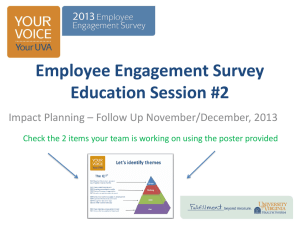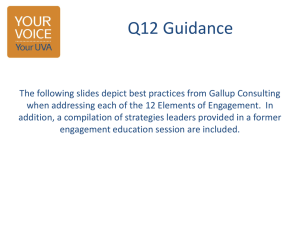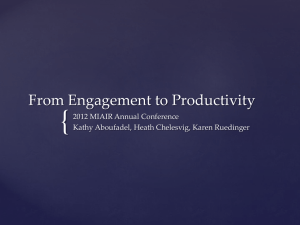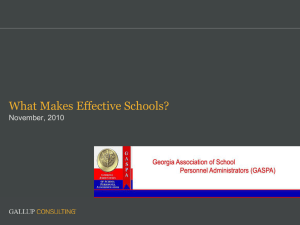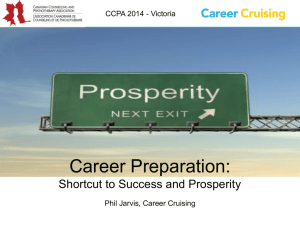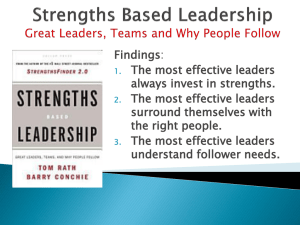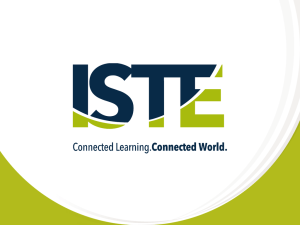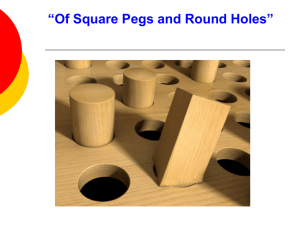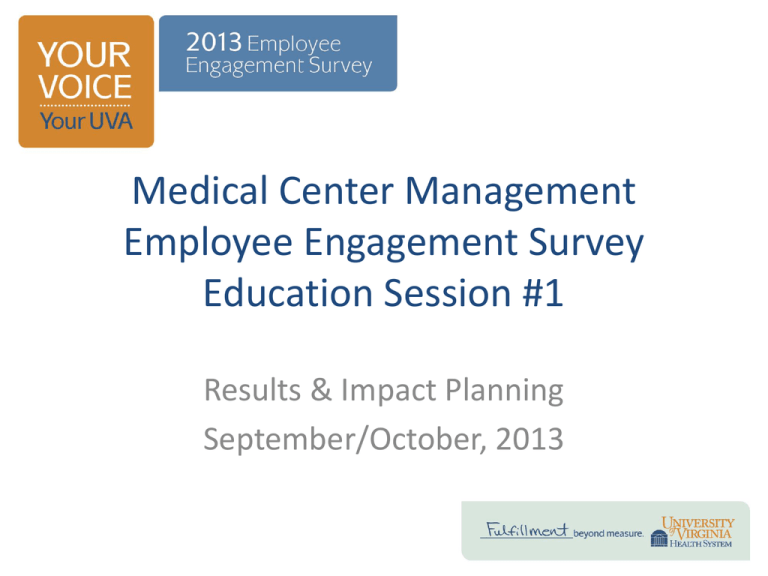
Medical Center Management
Employee Engagement Survey
Education Session #1
Results & Impact Planning
September/October, 2013
What we will cover today
1
•Gallup Theory
2
•Medical Center Results
3
•Workgroup Results
4
•Impact Planning
Group Work
Each person take 1 minute to
share with your tablemates
the best moment you’ve ever
had at work.
Using the provided “Notes” page,
take 1 minute to write down every
word you can think of that
describes how you felt during that
best moment at work.
How many of you feel you
were more productive
when you had these
feelings?
Copyright © 2013 Gallup, Inc. All rights reserved.
Everyone defines engagement using
the terms discretionary effort, but how
do you easily explain or demonstrate
it?
1
•Gallup Theory
2
•Medical Center Results
3
•Workgroup Results
4
•Impact Planning
The Big Picture
Q12
Employee
Engagement
Survey
Achieved
Mission
Sources of
Engagement &
Disengagement
Increased
Engagement
Team Impact
Plan
Usually the process
stops here
How does Gallup choose the
12 questions?
1 – Do you use employee satisfaction surveys?
2 – How often?
3 – How many questions are on your survey?
4 – Do your folks feel better or worse after the
survey?
The Sorting Effect
Poor Question
uu
u
u
u
u
u
Low rating
u
u
“I receive recognition.”
High rating
Great Question
uuuu
uuu u
u
u
Low rating
uu u
u
High rating
“In the last seven days, I have
received recognition or praise for
doing good work.”
For example:
Q03. At work, I have the opportunity to do what I do best every day.
Q04. In the last seven days, I have received recognition or praise for
doing good work.
u
Q10. I have a best friend at work.
More productive
workgroups
Less productive
workgroups
Gallup Engagement Hierarchy
The Q12®
Opportunities to learn and grow
Progress in last six months
I have a best friend at work
Coworkers committed to quality
Mission/Purpose of organization
At work, my opinions seem to count
Grow
Grow
Belong
Someone at work encourages my development
Supervisor/Someone at work cares
Recognition last seven days
Do what I do best every day
Give
I have materials and equipment I need to do my
work right
I know what is expected of me at work
Get
Copyright © 1993-1998, 2013 Gallup, Inc. All rights reserved.
The Gulf Between Yes and No
5 Very strong yes
4 Yes, but…
Psychological gap
3 Nice no
2 Solid no
1 Angry no
Copyright © 2013 Gallup, Inc. All rights reserved.
The effects of improving
engagement:
Absenteeism
Turnover
Quality
Theft
Customer Service
Safety Incidents
(patients and
employees)
Productivity
Profitability
1
•Gallup Theory
2
•Medical Center Results
3
•Workgroup Results
4
•Impact Planning
Response Rate
The survey was administered via Web from June 12-June 26, 2013
100%
88%
80%
84%
79%
76%
68%
Healthcare
1st Admin
Avg. 70%
60%
60%
40%
20%
0%
UVA
Health
System
2013
HSL
2013
MC
2013
SOM
2013
Note: Healthcare averages are based on Gallup’s 2013 Q12 Healthcare Workgroup-Level Database
SON
2013
Healthcare
Avg. 80%
UPG
2013
While the Medical Center scores are on target for Gallup 1st
time administration clients, this is not our first time to
administer a survey
GrandMean 50th percentile (HC Overall): 4.11
GrandMean 50th percentile (HC 1st Admin): 3.81
GrandMean Percentile (HC Overall):
5.00
GrandMean
4.00
26th
24th
29th
20th
33rd
3.80
3.76
3.84
3.70
UVA
Health
System
2013
HSL
2013
MC
2013
SOM
2013
SON
2013
UVA PG
2013
8,336
29
5,908
1,775
72
552
3.90
21st
3.72
3.00
2.00
1.00
0.00
n=
Note: Percentiles based on Gallup’s 2013 Q12 Healthcare Workgroup-Level Database
This is the distribution of ratings when compared to the
Gallup Healthcare database
%1
Overall
Satisfaction
Learn & Grow
Progress
Best Friend
Quality
Mission
Opinions
Development
6%
25%
5% 7%
17%
10%
12%
9%
6%
18%
Recognition
14%
26%
7%
Materials
8%
Expectations
9%
3.80
26th
3.90
31st
30%
3.57
20th
30%
3.49
26th
4.01
33rd
3.88
25th
3.52
33rd
3.81
33rd
4.06
33rd
3.49
34th
4.00
32nd
3.89
30th
4.39
32nd
36%
35%
34%
22%
34%
18%
24%
33%
13%
13%
Percentile
23%
39%
11%
6%
Mean
37%
21%
21%
9%
%5
30%
18%
7%
%4
34%
12%
6%
%3
44%
12%
Cares
Do Best
%2
31%
45%
16%
17%
34%
26%
32%
38%
20%
37%
37%
35%
32%
54%
Note: Percentiles based on Gallup’s 2013 Q12 Healthcare Workgroup-Level Database; numerical values shown when 5% or higher
Engagement: Three Types of
Employees
29%
37%
Engaged
Loyal and psychologically
committed. More productive;
higher retention.
52%
50%
Not Engaged
Productive, but they are not
psychologically connected to
their company. They miss more
workdays; more likely to leave.
19%
13%
Actively Disengaged
Physically present, but
psychologically absent. They
are unhappy and insist on
sharing this unhappiness with
others.
Typically, you need 5 engaged employees to offset every disengaged employee.
Copyright © 2008, 2013 Gallup, Inc. All rights reserved.
2.85:1
Based on Gallup Poll: U.S. Working Population 2012
There is some variance among job families within the
Medical Center
2013 Medical Center
GrandMean: 3.84
Percentile: 29th
Management
4.30
Finance
4.22
Computing
4.17
Pharmacy
3.95
Facilities and Trade
3.91
Percentile
N-Size
64th
261
58th
246
54th
215
37th
176
34th
724
Allied Health
3.87
31st
316
Administrative
3.86
30th
909
Labs
3.83
28th
218
Nursing
3.68
19th
1,869
Radiology
3.64
17th
138
Health Care Specialist
3.60
15th
621
0.00
1.00
2.00
3.00
Note: Percentiles based on Gallup’s 2013 Q12 Healthcare Workgroup-Level Database
4.00
5.00
Needs/concerns tend to vary at the different levels of
engagement
4 in 10 workgroups at the Medical Center were in the bottom quartile
of Gallup’s database in 2013 (compared to 46% for UVA overall).
100%
2013
% of Workgroups
75%
50%
41%
30%
25%
18%
12%
0%
Bottom 25%
2013 n=
Middle Quartiles
Top 25%
<3.78
3.78-<4.11
4.11-<4.44
4.44+
130
95
56
39
Note: Quartile designations based on Gallup’s Q12 Healthcare Workgroup-Level Database for the corresponding year;
Due to rounding, the percentages may add up to 100% ±1%
1
•Gallup Theory
2
•Medical Center Results
3
•Workgroup Results
4
•Impact Planning
Let’s get familiar with our
scorecards
Start a Movement
ttttttttttttttt
Informal Leaders as
Engagement Champions
400+ have attended the Informal Leader series
Find out who and thank them for their leadership
Tell them you look to them for added help in
understanding the scores
Come up with a plan to integrate them into the Impact
Planning process such as:
Leading Discovery Meetings (multiple shifts may require more
help)
Collecting and integrating data
Talking up the importance of everyone’s participation
Collecting goal data
1
•Gallup Theory
2
•Medical Center Results
3
•Workgroup Results
4
•Impact Planning
A new approach to Impact
Planning
5 Options:
A Two-Group Approach
Small cohorts within a larger workgroup
Interdisciplinary Teams
Senior Leadership
15-minute huddles
Expectations:
2 survey items, total of 4 actions
4-Step Process:
Discuss
Select
Plan
Follow
Up
Impact Planning
Discuss
I.
Select
Plan
Follow
Up
Discuss engagement and the survey results
Distribute the engagement scorecard and explain its mechanics.
(Utilize resources made available to you via the engagement website)
Discovery Meetings:
With your workgroup, explore the reasons behind the scorecard results;
brainstorm sources of engagement and sources of disengagement.
Use the last page of your scorecard as
a tool to develop questions to ask your team
prior to discussing the scorecard results
Copyright © 2013 Gallup, Inc. All rights reserved.
Discovery Meetings: Brainstorming Sources of
Engagement & Disengagement
Discuss
Select
Plan
Follow
Up
a) Percentage of 5’s — high
“Tell me what you are really excited about.”
b) Percentage of 1’s — high
“Tell me what you are upset/concerned about.”
c) Mean Comparisons
Level-over-level
.2 (meaningful difference)
“Tell me how you think we are different in comparison
to the group above us.”
HINT: Don’t compare the Grand Mean between items. The average is different for each. They
don’t relate to each other and the discussion is not relevant for change, it is more for
benchmarking purposes.
Copyright © 2013 Gallup, Inc. All rights reserved.
Copyright © 1993-1998, 2013 Gallup, Inc. All rights reserved.
What’s up with this item?
When the # of respondents is less than 10, only the %5
and mean scores are provided.
Copyright © 1993-1998, 2013 Gallup, Inc. All rights reserved.
What If I have Less Than 5?
When the # of respondents is less than 5, no percentages or
scores are provided.
Copyright © 1993-1998, 2013 Gallup, Inc. All rights reserved.
A Two-Group Approach to
Impact Planning
Discuss
Select
II. Select two questions on which to focus
a)
Plan
Follow
Up
3 mins
Divide your workgroup into two groups.
b) Ask group 1 to select a relatively low scoring item from page 3 of the
scorecard on which to work.
c)
Ask group 2 to select a relatively high scoring item from any of the Q12
on which to work.
Copyright © 2013 Gallup, Inc. All rights reserved.
A Two-Group Approach to
Impact Planning
Discuss
Select
Plan
Follow
Up
III. Plan four action items to work on those two survey questions
a)
Ask each group to brainstorm barriers to higher scores on its selected item.
5
mins
b)
c)
Ask each group to brainstorm possible ACTION ITEMS to address those
barriers — stress Span of Control.
5
mins
Ask each group to select the best two ACTION ITEMS for the survey
question they chose.
1
min
d)
Ask each group to modify their two ACTION ITEMS using the SMARTS filter.
Copyright © 2013 Gallup, Inc. All rights reserved.
Move From Dialogue to Action
d.) Ask each group to modify their two ACTION ITEMS using the SMARTS
filter.
Specific
S
= Specific
Well-defined
Provide clarity
Who? What? Where? When? How?
Measurable
M
= Measurable
A
= ActionOriented
Can you quantify the Action in some way?
Can you tangibly verify if the Action has
occurred?
Action-Oriented
Is the Action a behavior or a deliverable?
Is the Action filmable?
Realistic
R
= Realistic
Is this Action within the Span of Control of the
team?
Is the Action too big?
Timely
T
= Timely
When shall the team start? By when shall the
team be done?
If this is a recurrent Action, what’s the iteration
(e.g., “third Thursday of the month”)?
Strategic
S
= Strategic
The Action Item must be relevant to your
team’s core job responsibilities.
Will this Action distract the team from their
jobs or help them do their jobs?
Practical Tips for Effective
Impact Planning Sessions
The Importance of Pace
The Value of Shock and Awe
Keep it Quick — Brainstorming — NOT DISCUSSION
Potential Business Outcomes – 60 seconds
Barriers – 5 minutes
Potential Action Items – 5 minutes
Slow it Down – SMARTS – 15 minutes
Encouraging Ownership and Participation:
The Two-Group Approach
Rotating Leadership
Standing
Flipcharts
Cross-Group Consultation
Discouraging Domination by the Actively Disengaged
Copyright © 2013 Gallup, Inc. All rights reserved.
A Two-Group Approach to
Impact Planning
Discuss
Select
Plan
Follow
Up
IV. Follow Up to monitor, revise, and ensure Impact Plan execution
We will cover this in detail in Education Session #2!
Copyright © 2013 Gallup, Inc. All rights reserved.
How will we measure this?
2014 CENSUS ENGAGEMENT SURVEY
3 additional questions:
I received feedback on the previous Employee Engagement Survey
conducted at UVA Health System
My team participated in an effective impact planning session following
last year's Employee Engagement Survey
My team has made progress on the goals set during our impact planning
sessions after the last Employee Engagement Survey
Copyright © 2013 Gallup, Inc. All rights reserved.
DO NOT focus on the numbers,
instead focus on the rich dialogue gained through the
Discovery Meetings.
Empower others to act on what is in their control.
Education Timeline
Sept 4
MC Chiefs & Administrators – Engagement Results &
Recommendations with Gallup (9:30-10:30)
Health System Executives – Engagement Results &
Recommendations with Gallup (1:00-2:00)
Sep t11
MCMG Meeting – Present overview of results
Sept 16
MC Management Email from Gallup with link to Gallup
Online
Sept 19 - Oct 4
MC Management Education #1– Results sessions
Oct 10
Employee Council Meeting – Present overview of results
Oct 17
PNSO Cabinet Meeting – Present overview of results
Nov/Dec 2013
MC Management Education #2 – 2 Group Approach to
Impact Planning
Mar/Apr 2014
MC Management Education #3 – Achieving Our Mission &
Changing Our Culture
May 2014
Health System Census Survey
Next Steps
Discuss this process and your plan with your Informal
Leaders
Pick 1 of the 5 Impact Planning options you will use to
hold Discovery meetings with your workgroup
Hold Discovery Meetings
Enroll in Education Session #2
Bring SMARTS goals

